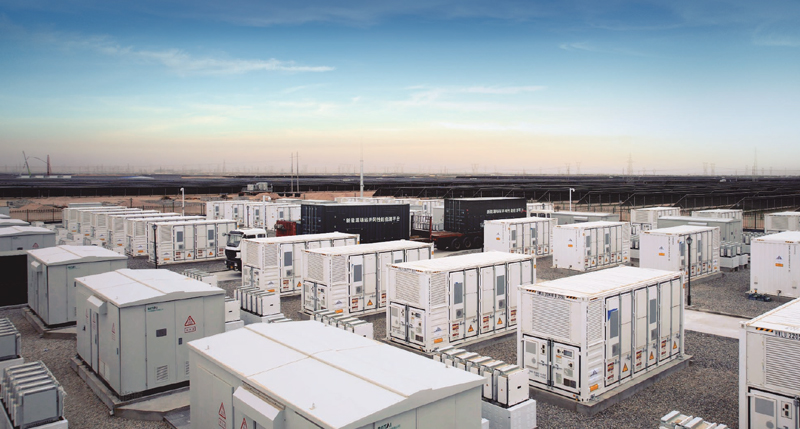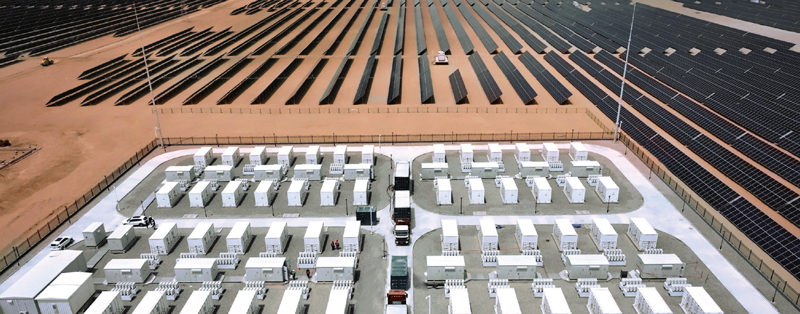CGDG: A Project in Golmud Writes a New Chapter in Grid-Forming Energy Storage
As we continue to pursue carbon neutrality, renewable energy is taking on a bigger role in the global energy mix. New power systems often rely primarily on clean energy, such as wind and solar power. As this evolution speeds up, we will inevitably see a larger proportion of clean energy being connected to the power grid.

As a crucial ecological barrier in Haixi Prefecture, Qinghai Province, Golmud City has abundant solar, wind, hydro, and geothermal energy resources. However, as this region produces and feeds more renewable energy to the power grid, grid stability becomes more vulnerable. This is a common issue in renewable energy development worldwide.
Grid-forming energy storage systems (ESSs) can actively support power grids and ensure safe and stable power system operations. As such, projects are increasingly using grid-forming ESSs to coordinate multiple types of power supplies, such as PV, wind, and solar thermal power. The 50 MW/100 MWh grid-forming ESS project for the multi-energy renewable power plant in Golmud, Qinghai, is a prime example. The project was developed by the China Green Development Investment Group (CGDG) and completed in January 2024.
A new frontier in the clean energy industry
Located in the hinterland of the Qinghai-Tibetan Plateau, Golmud is endowed with abundant natural resources. The vast land, abundant sunlight, and strong winds provide fertile ground for the development of the clean energy industry in this city.
For years, Golmud has actively introduced advanced technologies in energy storage and PV, wind, and solar thermal power. This has helped the city continuously improve the quality and scale of its clean energy development, approaching a new frontier in the clean energy industry.
In the first half of 2024, 88.2% of the electricity generated in Golmud came from clean energy sources, indicating a significant improvement in clean power supply capacity. However, this rapid growth also suggests a need for higher safety when integrating clean energy into Golmud's power grid.
The CGDG 50 MW/100 MWh grid-forming ESS project in Golmud is part of the answer, which uses Huawei Digital Power's Smart String Grid-Forming ESS as its core technology.
The project is located in the city's PV industrial park. The total installed capacity is 700,000 kW, including 200,000 kW of PV power, 400,000 kW of wind power, 50,000 kW of solar thermal power, and 50,000 kWh in ESSs.
Part of the challenge in Golmud is its weak power grid. To address this, Huawei's Smart String Grid-Forming ESS proactively supports the power grid and enables renewable power systems to work just as reliably as conventional generators. This is significantly increasing the integration of renewable energy into the power grid.
This project solves the challenges that often accompany renewables, such as low stability and inertia. It delivers a future-oriented solution for areas with a high installed capacity and proportion of renewables and lays a solid foundation for Golmud to further develop its clean energy industry.
Project progress alongside technical exchanges
Building an ESS plant is already a challenging task. In regions like Golmud, with high altitude, dry climate, and intense ultraviolet radiation, constructing a 50 MW/100 MWh Smart String Grid-Forming ESS plant is even more difficult.
Despite challenges such as a tight project timeline, high altitude, strong winds, and low temperatures, CGDG and Huawei Digital Power worked closely together and successfully completed various construction tasks on schedule.
The China Electric Power Research Institute, Northwest Branch of State Grid Corporation of China, State Grid Qinghai Electric Power Company, CGDG, and Huawei Digital Power jointly tested the grid-forming ESS grid connection performance. These tests verified the solution's performance, its compatibility with various types of power supplies, and the parallel operation capabilities of multiple devices.
Testing included the world's first 35 kV and 110 kV short-circuit test. Even during the induced short-circuit fault, over 600 power conversion systems (PCSs) were running reliably and stably to provide fast reactive power support for the system.
CGDG and Huawei Digital Power have made impressive strides. They have successfully developed a zero-carbon power system and added stability to the power grid with a high proportion of renewable energy. They have also explored the necessary technical specifications and policy mechanisms to develop a multi-energy complementary system that interconnects several energy sources. These insights are valuable for researching, reserving, and applying grid-forming energy storage technologies.
In addition, the two companies have researched how power transmission works in grids with a high proportion of renewable energy in multi-energy complementary scenarios. Drawing on this research, they came up with a plan for the Qinghai power grid to develop solar thermal plants that can support the ultra-high-voltage DC project in Haixi. Finally, they carried out a technical and economic feasibility demo that supports Qinghai's renewable energy development.
These actions showcase two key points of innovation. They have generated new green policies for the sustainable development of multi-energy complementary systems and a development model for solar thermal plants. They have also provided practical support for relevant national policies, aiming to form a long-term mechanism to advance energy transitions.
Facilitating the construction of a new power system
On May 31, 2024, the CGDG 50 MW/100 MWh grid-forming ESS plant officially went live in Golmud, Qinghai. This plant is a best practice when it comes to increasing the proportion of renewable energy in Qinghai's power grid. It also effectively solves some of the challenges related to renewable energy integration into weak power grids.

On June 15, the 35 kV three-phase short-circuit test was completed. It verified the ESS's and the plant's frequency and voltage regulation capabilities in response to different voltage levels and asymmetric fault events.
Then, on June 30, the 110 kV single-phase short-circuit test was completed. It confirmed that even during a short-circuit fault, over 600 PCSs could run reliably and stably to provide fast reactive power support for the system.
These stringent tests illustrate that Huawei's Smart String Grid-Forming ESS is compatible with various types of power supplies, enables multiple devices to work in parallel, and supports large-scale integration and distribution of renewable energy.
Huawei Digital Power is committed to enhancing the safety and stability of renewable integration by combining digital and power electronics technologies, leveraging technical experience, and collaborating with global power companies, grid enterprises, and electricity providers to continuously promote the development of grid connection technologies.
To ensure comprehensive safety from cell to grid, Huawei has built an ESS that offers ultimate safety through cell-level isolation, pack-level fire suppression, and rack-level 6-layer protection. Besides, the BMS implements multi-dimensional intelligent diagnosis across the entire link. All these features improve the active safety of the ESS.
Recognizing the importance of grid-forming energy storage, China's National Energy Administration has published a series of notices and action plans to encourage the large-scale application of grid-forming energy storage, accelerate the construction of new power systems, and enable the industry's sustainable development.
As a leader in the field of digital power, Huawei will continue to innovate in renewable energy grid connection and grid-friendly technologies. It will also deepen the integration of digital and power electronics technologies to drive the development of new power systems.



 Search
Search
 EN
EN









